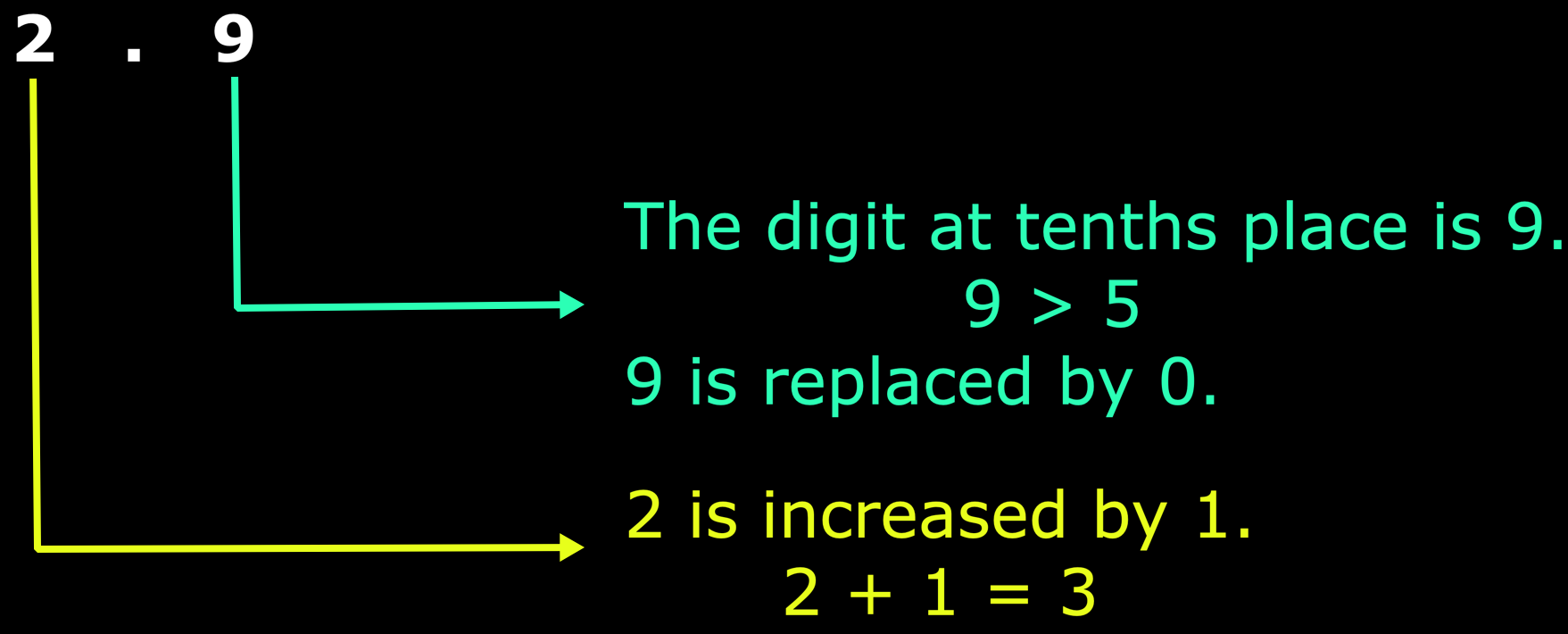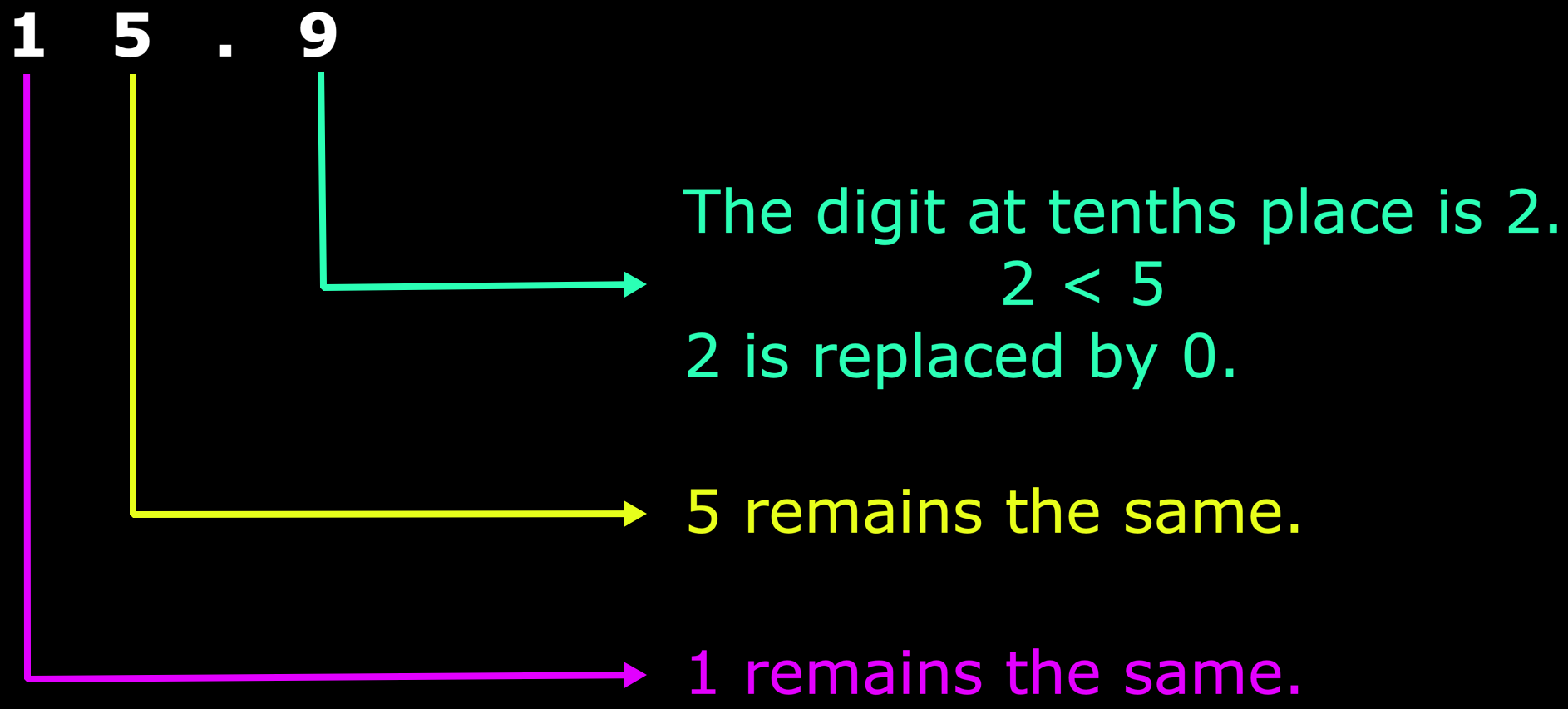Subscribe to our ▶️ YouTube channel 🔴 for the latest videos, updates, and tips.
Rounding Decimals
Rounding decimals are frequently used in our daily life mainly for calculating the cost of the items. In mathematics rounding off decimal is a technique used to estimate or to find the approximate values and to limit the amount of decimal place.
We round off the numbers or approximate the value of decimal to a specified decimal place to make it easy to understand, instead of having a long string of decimal places.
In, rounding decimals we will
learn how to round a decimal in different conditions.
● Rounding off to the nearest whole number means, rounding off a decimal to the nearest whole number.
● Rounding off to the nearest tenths means, rounding off a decimal number correct to 1 decimal place.
● Rounding off to the nearest hundredths means, rounding off a decimal number correct to 2 decimal places.
● Rounding off to the nearest thousandths means, rounding off a decimal number correct to 3 decimal places.
ROUNDING OFF A DECIMAL NUMBER
We round off a decimal in the same way as we round off a whole number. We can round off a decimal to the nearest one, tenth, hundredth, etc. But, while rounding off a decimal, we do not consider the zeros on the extreme right of the decimal point. Let us consider some examples.
I. Round off the following decimals to the nearest one.
(i) 2.9
(ii) 15.2
Solution:
(i) To round off 2.9 to the nearest one, we consider the digit at tenths place.
So, 2.9 can be rounded off to its nearest one as 3.
(ii) To round off 15.2 to the nearest one, we consider the digit at tenths place
So, 15.2 can be rounded off to its nearest one as 15.
II. Round off the following decimals to the nearest tenth.
(i) 7.58
(ii) 18.624
Solution:
(i) The digit at hundredths place in 7.58 is 8.
8 > 5
So, 7.58 can be rounded off to its nearest tenth as 7.60 or 7.6
(ii) The digit at hundredths place of 18.624 is 2.
2 < 5
So, 18,624 can be rounded off to its nearest tenth as 18.6.
III. Round off each of the following to the nearest hundredth.
(i) 7.346
(ii) 28.723
Solution:
(i) The digit at thousandths place in 7.346 is 6.
6 > 5
So, 6.346 can be rounded off to its nearest hundredth as 6.35.
(ii) The digit at thousandths place of 28.723 is 3.
3 < 5
So, 28.723 can be rounded off to its nearest hundredth as 28.72.
ROUNDING OFF RECURRING DECIMALS
Some decimals have endless digits as
0.7777..........,
0.050505..........,
0.924386924336.......... etc.
Such decimals are called recurring decimals.
Let us consider some examples
I. Round off 0.1666.......... to the nearest tenth
Solution:
The digit at the hundredths place is 6. 65 So, we can round off 0.1666. as 0.2 to its nearest tenth
II. Round off 0.7777 to the nearest hundredth
Solution:
The digit at the thousandths place is 7
7 > 5
So, 0.7777.......... can be rounded off as 0.78 to its nearest hundredth.
Note:
(a) When the rounded number is less than the number itself, it means the number is rounded down.
(b) When the rounded number is greater than the number itself, it means the number is rounded up.
● Related Concept
● Decimals
● Conversion of Unlike Decimals to Like Decimals
● Decimal and Fractional Expansion
● Converting Decimals to Fractions
● Converting Fractions to Decimals
● H.C.F. and L.C.M. of Decimals
● Repeating or Recurring Decimal
● BODMAS/PEMDAS Rules - Involving Decimals
● PEMDAS Rules - Involving Integers
● PEMDAS Rules - Involving Decimals
● BODMAS Rules - Involving Integers
● Conversion of Pure Recurring Decimal into Vulgar Fraction
● Conversion of Mixed Recurring Decimals into Vulgar Fractions
● Rounding Decimals to the Nearest Whole Number
● Rounding Decimals to the Nearest Tenths
● Rounding Decimals to the Nearest Hundredths
● Simplify Decimals Involving Addition and Subtraction Decimals
● Multiplying Decimal by a Decimal Number
● Multiplying Decimal by a Whole Number
● Dividing Decimal by a Whole Number
● Dividing Decimal by a Decimal Number
From Rounding Decimals to HOME PAGE
Didn't find what you were looking for? Or want to know more information about Math Only Math. Use this Google Search to find what you need.




New! Comments
Have your say about what you just read! Leave me a comment in the box below. Ask a Question or Answer a Question.